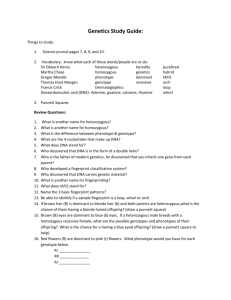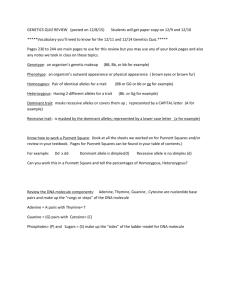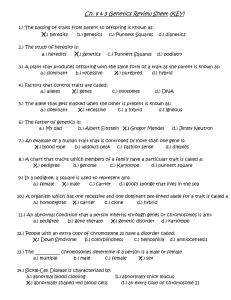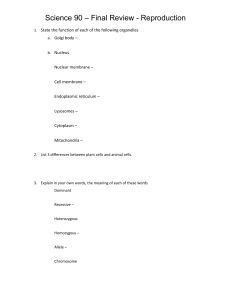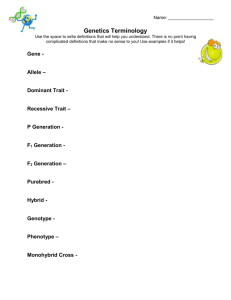Punnett Squares – Dominance, Incomplete Dominance, Co
advertisement
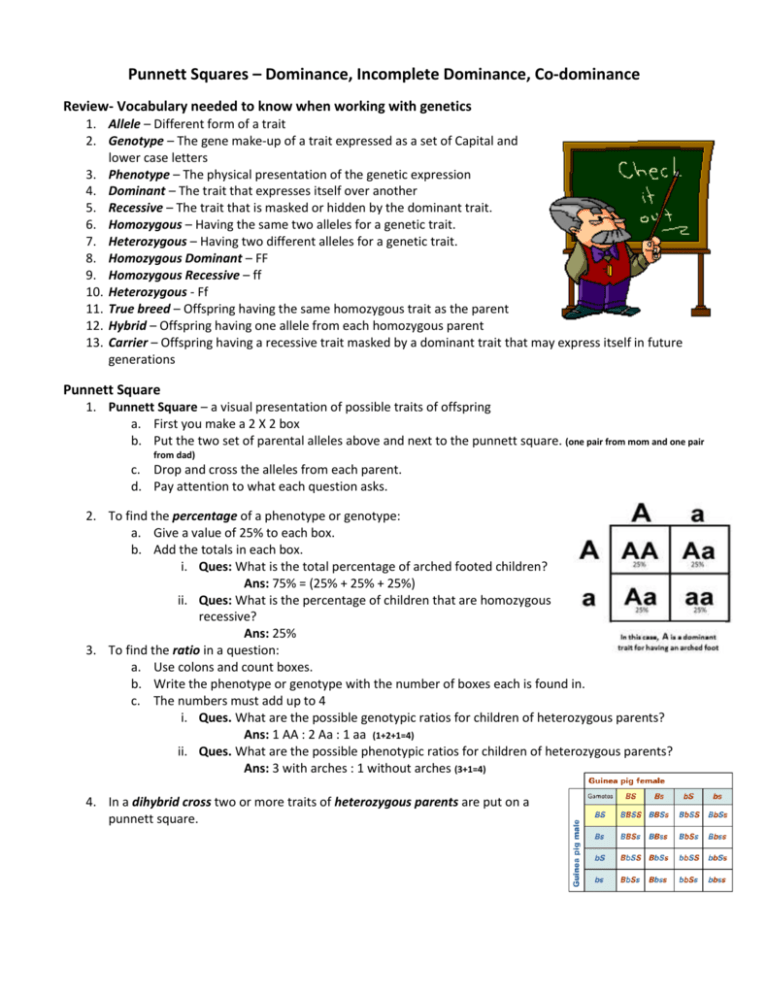
Punnett Squares – Dominance, Incomplete Dominance, Co-dominance
Review- Vocabulary needed to know when working with genetics
1. Allele – Different form of a trait
2. Genotype – The gene make-up of a trait expressed as a set of Capital and
lower case letters
3. Phenotype – The physical presentation of the genetic expression
4. Dominant – The trait that expresses itself over another
5. Recessive – The trait that is masked or hidden by the dominant trait.
6. Homozygous – Having the same two alleles for a genetic trait.
7. Heterozygous – Having two different alleles for a genetic trait.
8. Homozygous Dominant – FF
9. Homozygous Recessive – ff
10. Heterozygous - Ff
11. True breed – Offspring having the same homozygous trait as the parent
12. Hybrid – Offspring having one allele from each homozygous parent
13. Carrier – Offspring having a recessive trait masked by a dominant trait that may express itself in future
generations
Punnett Square
1. Punnett Square – a visual presentation of possible traits of offspring
a. First you make a 2 X 2 box
b. Put the two set of parental alleles above and next to the punnett square. (one pair from mom and one pair
from dad)
c. Drop and cross the alleles from each parent.
d. Pay attention to what each question asks.
2. To find the percentage of a phenotype or genotype:
a. Give a value of 25% to each box.
b. Add the totals in each box.
i. Ques: What is the total percentage of arched footed children?
Ans: 75% = (25% + 25% + 25%)
ii. Ques: What is the percentage of children that are homozygous
recessive?
Ans: 25%
3. To find the ratio in a question:
a. Use colons and count boxes.
b. Write the phenotype or genotype with the number of boxes each is found in.
c. The numbers must add up to 4
i. Ques. What are the possible genotypic ratios for children of heterozygous parents?
Ans: 1 AA : 2 Aa : 1 aa (1+2+1=4)
ii. Ques. What are the possible phenotypic ratios for children of heterozygous parents?
Ans: 3 with arches : 1 without arches (3+1=4)
4. In a dihybrid cross two or more traits of heterozygous parents are put on a
punnett square.
Complete Dominance
1. This is the type of Dominance Mendel studied.
2. The traits he studied were either/or traits.
a. Either dominant (capital letter) or recessive (lowercase letter)
3. The dominant trait will show
4. The recessive trait is hidden
5. The person that is heterozygous is a carrier of the trait
Incomplete Dominance
1. Unlike Complete dominance, there are NO lowercase letters.
2. NEITHER trait has dominant control
3. A mixed color or a blending is made.
a. To remember a mixed color is made, think of the {m} in
inco{m}plete.
4. Dominant red is written as {RR} (a purebred - homozygous)
5. Dominant white is written as {WW} (a purebred - homozygous)
6. The mixed color they make is pink {RW} (a hybrid - heterozygous)
Codominance
1. Like Incomplete dominance, there are NO lowercase letters.
a. This time, both traits express themselves in different locations
2. The punnet square will be written exactly as in incomplete dominance.
a. One dominant color is written as {RR} (a purebred homozygous)
b. The other dominant white is written as {WW} (a purebred homozygous)
c. The both colors showing will be written as {RW} (a hybrid - heterozygous)
d. A cow or horse with both colors (usually brown and white) showing is called a “roan” horse or cow.
Extra
1. Sometime codominance is written as Superscripts (letters above writing) with a
common letter representing a trait.
a. In the example {H} stands for horse color.
b. HB stands for a brown horse
c. HW stands for a white color
2. Again there are NO lower case letters written in the superscript position
3. Terms for homozygous and heterozygous now refer to the superscripts
4. Percentages and ratios are done the same way with the different notation
5. You may see this notation when doing crosses with blood
Study Guide Questions for this Material
1. Can you define the vocabulary words in the review section?
2. Make a punnett square cross for the following:
{H} is for hitchhikers’ thumb a dominant trait over straight thumb {h}. What
would hap pen if you crossed a father who has the homozygous dominant trait
with a mother who is homozygous recessive?
3. What type of letters are used with Complete dominance and why?
4. What is different about Incomplete and Codominance compared to Complete Dominance?
5. What is the difference between Incomplete Dominance and Codominance?
6. If you were asked to find the percentage of a phenotype or genotype, what would you do?
7. If you were asked to find the ratio of a phenotype or genotype, what would you do?
8. What would be the phenotypic ratio for the offspring if {L} (left handed) were dominant over {l} right
handed?
9.
What would be the genotypic ratio for the offspring if {L} (left handed) were
dominant over{l} right handed?
10. What would the heterozygous genotype be of a flower that is White and Red if these traits were said to
have incomplete dominance?
11. What would the phenotype be of a flower that is White and Red if these traits were said to have
codominant?





